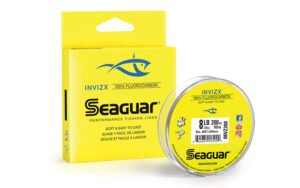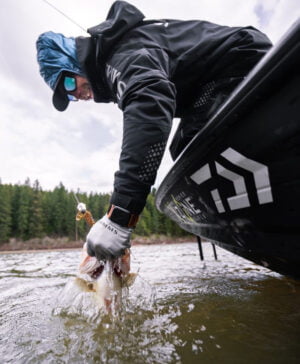Flat-Sided Crankbaits for Cold Water Bass

Part of what makes crankbaits such an effective tool in bass fishing is their ability to match a variety of forage. These baits come in many different sizes, diving depths, styles, actions, and a rainbow of color options. When choosing the perfect one for the job, anglers must consider water temperature, clarity, and what the fish are eating.
While some months may be a little confusing, some guesswork is eliminated during the coldest months of the year as Bassmaster Elite Series pros Keith Combs and Brandon Palaniuk each reach for one type this time of year: flat-sided crankbaits.
Combs’ Cold Water Cranking Approach

Texas pro-Keith Combs’ affinity for crankbaits is well documented. He’s scored major tournament wins with them and while most of the time it’s with jumbo deep-diving baits, he knows there’s a time and place for other baits.
“For me, a flat-sided crankbait is a cold water deal,” he said. “That time will vary based on where you live. Here in East Texas, it’s when the water is around 50 degrees, and somewhere further north, like Tennessee, for example, the window might be when the water is around the 40-degree mark.”
While some might assume that cold means it’s time to head to deeper water, Combs says that’s not always the case. “You can still focus on shallow water, but you want to be close to deeper water.”
That opens up various areas, according to Combs and much of it will depend on where he’s fishing.
“If you are up the rivers on a lake, it might be the channel and creek bends, where you have shallow water very close to deep water,” he said. “It might also be rock, whether natural or manmade, like riprap and causeways on the main lake. Those areas generally have both shallow and deep water and are great places to throw flat-sided crankbaits in the colder months.”
Flat-sided crankbaits are effective tools in the cold because they have a tighter wobble than more aggressive baits like squarebills and deep-divers that feature a more rounded body. Combs fishes several but prefers the Strike King KVD Flat Side 1.5 because it stays tight, even at very slow speeds.
“Some baits have a tight action when you fish them with a standard retrieve but start to have a wider action when you slow down,” he said. “Fishing this time of year is when you need to slow down tremendously and that bait stays tight even at the slowest speeds. I always test different baits next to the boat to see how they perform with changes in my retrieve speed.”
When fishing flat-sided crankbaits, Combs uses much of the same approach he does with bigger baits and says a deflection off of cover or structure is always a way to trigger bites.
“Even when it’s colder, you still want the bait to deflect and hit something because that will get a fish to bite,” he said. “When I make a cast, I always try to get the bait to dig into the bottom or come in contact with cover. The other thing I’ll do with these baits is to twitch my rod or make a faster reel crank a few times during the retrieve to impart more action, just in case there is one following the bait. I’ve caught some key fish over the years with that trick.”
For his flat-sided crankbaits, Combs utilizes a 7-foot, 2-inch medium-heavy Shimano Expride glass composite rod paired with a 7.4:1 Shimano Metanium MGL reel. Both of these items help him with casting distance with a light lure, and the combo’s sensitivity helps him detect sluggish bites.
 For line, Combs almost exclusively uses Seaguar InvizX fluorocarbon for his cranking needs. With these small baits, 10 and 12-lb test get the nod. “When fishing in cold weather, line memory can become a big issue and you don’t have any of that with InvizX because it’s so soft,” he said. “It does great, even if the temperatures are around freezing. Plus, it’s a great line for getting more distance on your cast, which is very important with all crankbaits.”
For line, Combs almost exclusively uses Seaguar InvizX fluorocarbon for his cranking needs. With these small baits, 10 and 12-lb test get the nod. “When fishing in cold weather, line memory can become a big issue and you don’t have any of that with InvizX because it’s so soft,” he said. “It does great, even if the temperatures are around freezing. Plus, it’s a great line for getting more distance on your cast, which is very important with all crankbaits.”
Palaniuk’s Flat-Side Fandom

Like Combs, reigning Bassmaster Elite Series Angler of the Year, Brandon Palaniuk knows there is a time and place for this crankbait style. When and where he uses them varies, but the common theme is cold weather.
“It’s not black and white in terms of a specific water temperature when they work,” Palaniuk begins. “Each fall, there is a window when the water is somewhere in the 50s when jerkbaits really start to work well and that’s when I also start thinking of flat-sided crankbaits. You can start then and do it all winter long in many regions of the country.”
Where he throws them also depends on the lake, but rock transitions are areas that always seem to produce for him. “It could be a bluff wall that turns into chunk rock or chunk rock to pea gravel,” he said. “Those are always obvious places for me to start and it’s because a lot of times, those are places where the steepness of the bank changes. It gives the fish deep water and a shallower shelf that they can use to ambush baitfish.”
Palaniuk prefers to fish down a bank with his boat positioned parallel to the bank and make 45-degree angle casts toward the bank. “This keeps your bait in the strike zone much longer,” he shared.
 When fishing these areas, whether it’s with a Rapala Shad Rap, Berkley Frittside, or homemade balsa bait, Palaniuk selects his gear with casting distance in mind.
When fishing these areas, whether it’s with a Rapala Shad Rap, Berkley Frittside, or homemade balsa bait, Palaniuk selects his gear with casting distance in mind.
“These are light baits and casting them effectively is a big part of the equation,” he said. “I’ll always use a casting rod if I can get away with it, but there are times when you have to switch to spinning gear to get a better cast.”
His rods of choice are the Alpha Angler Rebound, a 7-foot medium-heavy glass cranking rod, and a 7-foot, 2-inch medium spinning rod that Alpha Angler designed for spybaits. He’ll pair the casting rod with a 6.3:1 Daiwa Zillion SV and the spinning with a Daiwa Exist reel. Seaguar Tatsu fluorocarbon is his preferred line for both setups, anywhere from 8 to 12 lb test, depending on the bait he’s using and the cover he is fishing around.
 “What makes Tatsu so good, in my opinion, is the diameter-to-strength ratio,” he said. “Even when you are cranking around rocks, you still have durability because it’s a double structure fluorocarbon, so it’s very strong but also soft enough to give you great casting distance. The thinner diameter also helps give these baits a more natural action because there is less resistance in the water.”
“What makes Tatsu so good, in my opinion, is the diameter-to-strength ratio,” he said. “Even when you are cranking around rocks, you still have durability because it’s a double structure fluorocarbon, so it’s very strong but also soft enough to give you great casting distance. The thinner diameter also helps give these baits a more natural action because there is less resistance in the water.”
Fishing flat-sided crankbaits is something that works like clockwork every winter. They are valuable tools that appeal to the slowing metabolisms of bass but still allow anglers to cover water quickly in search of their next bite.
Seaguar Tatsu Fluorocarbon mainline is available from 4 to 25-lb test on 200 and 1,000 yard spools
Seaguar InvizX Fluorocarbon mainline is available from 4 to 25-lb test on 200, 600 and 1,000 yard spools

